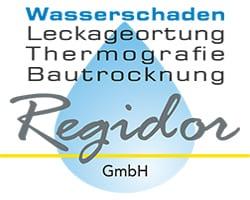Quantitative instant analysis
In various cases, an immediate quantitative analysis of the contaminated components makes sense. For these cases, we have the analysis method of Regidor Service GmbH at our disposal, which can determine the quantitative contamination by mould fungi, bacteria and faecal germs on surfaces and in materials on site. It is also possible to examine the indoor air for mould spores and to take samples of drinking water.
"With the mobile laboratory, we won't keep you waiting!"
The enthusiasm knows hardly any bounds, because now things are moving fast with contaminated components.
The internationally proven method for direct analysis on the construction site, in your home or at the workplace.
Mycometer is a precise analysis method that can be used to perform on-site quantitative testing for mould, bacteria and faecal germs on surfaces and in materials. Indoor air can also be analysed for mould spores. In addition, samples of drinking water are possible. The method was developed as early as 1998 by mycologists at the University of Copenhagen in cooperation with building experts and remediation specialists and has been recognised by the National Building Research Institute in Denmark and tested by the US EPA. Therefore, it has been standard in Scandinavia for years, but is also known and proven worldwide and increasingly in Europe.
- Immediate result after approx. 30 minutes
- No construction stop due to laboratory runtimes
- Reduces costs for customers and property insurers
- Immediate decision to clean or dismantle
- Quantitative analysis of mold and bacteria
- Analysis differentiates between mold and bacteria
- Considerable cost savings for property insurers
- Immediate clarity on the success of clearance measurements
- Internationally recognized validated procedure
- Professional technology, can only be used by certified specialists
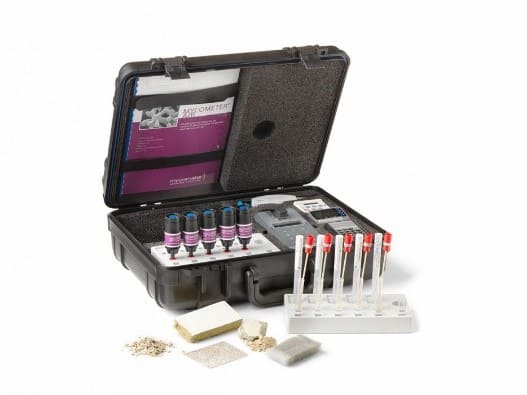
We test and analyse air, materials, surfaces and water for you
.Direct analyses are very well thought-out concepts, grown to meet the requirements in the specialist area of "buildings & living". With this system, we collect all the important parameters that are really important for you as a building user.
Air measurement (free measurement)
The Mycometer-Air Method
Mycometer-air is a precise analysis method that allows on-site quantitative mould measurements in indoor air. The method is recognised by the Danish National Building Research Institute and has been tested by the US Environmental Protection Agency (US EPA).
The method differs fundamentally from traditional methods for indoor air measurements, which measure airborne germs or airborne particles. The Mycometer-air method detects the entire mould mass, both germinable and non-germinable spores. The measurement detects mould directly on the sampling filter and can be carried out on site using laboratory equipment. The analysis time is approx. 30 minutes, so that a standardised report can already be prepared on site. The guide value scale can be used as a limit value for control measurements after remediation. The measurement results are reproducible. The air samples may only be taken by persons with certification.
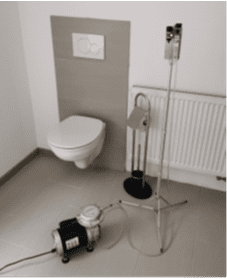
Bactiquant surface (bacteria)
Bacteria are everywhere, in humans, animals, food, water, air and on organic and non-organic surfaces. Bacteria in buildings is unavoidable and some background level of bacteria is to be expected in all buildings.
In general, this background level of bacteria does not result in a health risk to building occupants. However, in some cases, an increased presence of bacteria may occur. If the presence of bacteria is far above the normal expected background level, a health risk to building occupants cannot be ruled out.
In general, this background level of bacteria does not result in a health risk to building occupants.
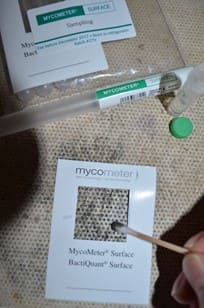

An increased level of bacteria in buildings can have the following causes, among others:
Growth of bacteria in buildings
.Bacteria can grow on building components or surfaces that are very damp over a long period of time and, under certain circumstances, can pollute the indoor climate and possibly trigger health restrictions for building occupants.
This moisture damage can occur, for example, due to basic moisture, leaks or leakages.
Intrusion of bacteria into buildings:
Floods or sewage damage can cause large amounts of bacteria to enter buildings. When flooding occurs, for example after cloudbursts or when sewage pipes leak, sewage contaminated with bacteria can contaminate buildings. The contamination occurs primarily on horizontal surfaces.
Mycometer-Surface (moulds)
As a rule, this background level of mould does not result in any health hazards for building occupants. In some cases, however, an increased occurrence of mould may occur.
When the occurrence of mould is far above the normal expected background level, a health burden for building occupants cannot be excluded.
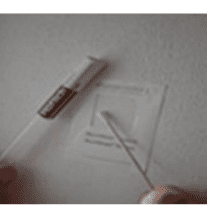
Elevated levels of mould in buildings can be caused by the following, among other things:
.Although most building materials provide adequate nutrients for mould growth, surfaces in damage-free buildings are not infested with mould under normal conditions. This fact is not due to a lack of microorganisms, but rather to a lack of moisture, which the fungi need to grow.
Mould growth in the building:
The real problem caused by mould in buildings, however, arises in conjunction with moisture. When sufficient free water is available to the germinating mould spores, mould growth occurs. When mould grows, the mould can produce large quantities of mould spores and release them into the room air.
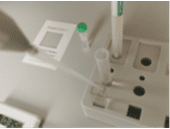
With the mobile analysers in the transport case, it is possible to evaluate up to 10 samples in about 30 minutes. Mycometer- Surface registers the entire biomass, spores, hyphae, fragments and also the non-viable cells.
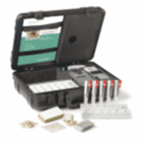
Mycometer material samples
This applies to material with hard and dense surfaces. However, if the material is particularly porous, the mould may also be able to penetrate the material.
In these cases, it is not uncommon for a large amount of mould biomass to be present in the material, which cannot be detected with surface measurements.
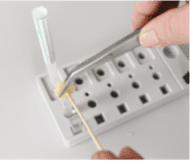
With the Mycometer Material Sampling Analysis Kit, mould in porous building materials such as artificial mineral fibres, as well as lime-cement-based building materials can also be quantitatively detected and evaluated.
